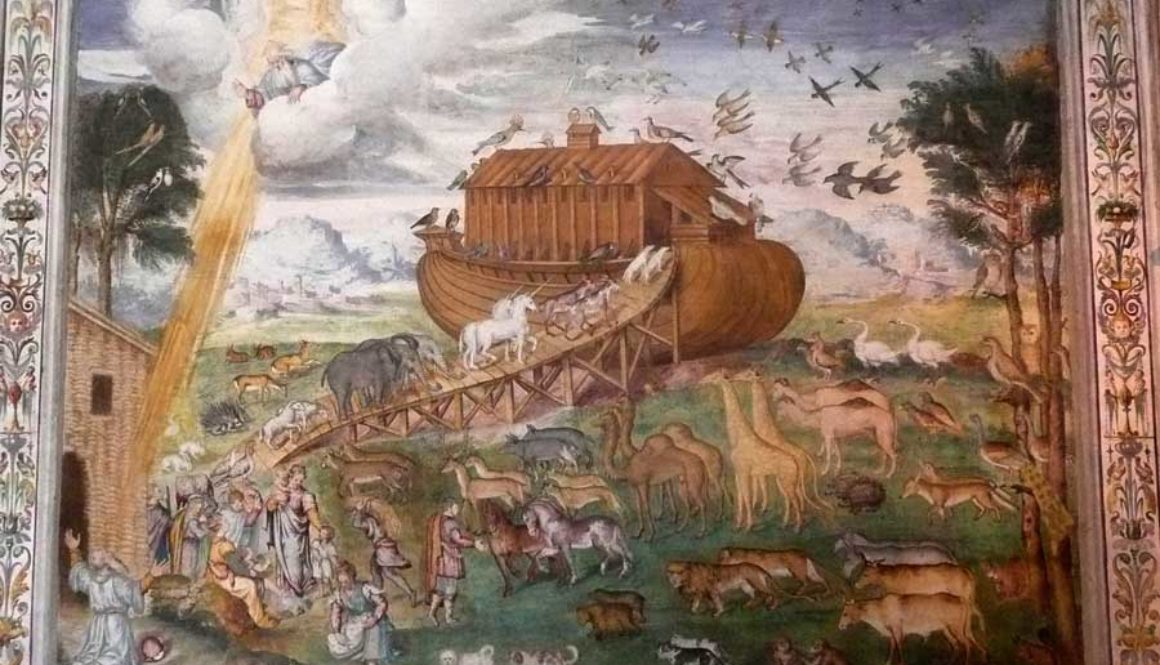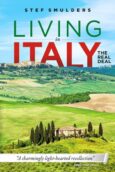7 Secrets of Milan – Hidden Gems you overlooked (until now)
Everybody knows the magnificent Duomo of Milan, the Galleria, the Scala, the fashion district. But there are a few esser known or less visited sights of Milan, that definitely are also worth visiting during a stay in the city. And there are few examples of these secrets in the nearby hinterland of Milan as well.
- The San Maurizio church
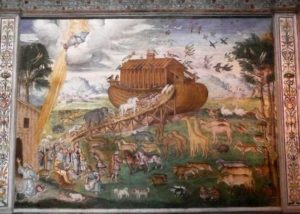 This is a beautiful Renaissance church , next to a monastery and situated along the Corso Magenta , the street that leads up to the Santa Maria delle Grazie (Last Supper). The church is decorated with splendid 16th century frescoes , mainly by Luini , very recently restored (2010). Highly recommended. Other highlights are the Cappella Simonetta with the Deposizione di Cristo by Callisto Piazza; the Adorazione dei Magi by Antonio Campi; the 16th century organ in the Capella Simonetta; the Cappella Besozzi with a fresco of the decapitation of Saint Catherine; the dividing wall , attributed to Luini. Part of the former monastery is now taken up by the Museo Archeologico . Each year in spring a cycle of concerts is held in the church, the Musica e Poesia a San Maurizio . In July and Sept/Oct there are special Thursday evening openings till 10pm where your visit is accompanied by Renaissance and Baroque music. Not accessible for the disabled (7 steps).
This is a beautiful Renaissance church , next to a monastery and situated along the Corso Magenta , the street that leads up to the Santa Maria delle Grazie (Last Supper). The church is decorated with splendid 16th century frescoes , mainly by Luini , very recently restored (2010). Highly recommended. Other highlights are the Cappella Simonetta with the Deposizione di Cristo by Callisto Piazza; the Adorazione dei Magi by Antonio Campi; the 16th century organ in the Capella Simonetta; the Cappella Besozzi with a fresco of the decapitation of Saint Catherine; the dividing wall , attributed to Luini. Part of the former monastery is now taken up by the Museo Archeologico . Each year in spring a cycle of concerts is held in the church, the Musica e Poesia a San Maurizio . In July and Sept/Oct there are special Thursday evening openings till 10pm where your visit is accompanied by Renaissance and Baroque music. Not accessible for the disabled (7 steps). - The San Marco of Milan
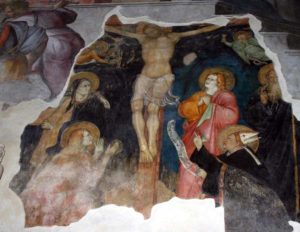 The church of San Marco is located in the Brera district , and as the mother house of the order of St Augustine it contains artworks related to Augustinian subjects: a fresco by the Fiammenghinis depicting Alexander IV Instituting the Order of the Augustinians; 16th-century frescoes by Lomazzo that narrate the stories of Saint Peter and Saint Paul; the peculiar nativity scene made of paper; the sarcophagus of the blessed Lanfranco Settala , including the statue of the deceased surrounded by angels and saints; underneath the Settala tomb precious frescoes were found among which a crucifixion attributed to a 14th-century Lombard master; the Martino Aliprandi sarcophagus with its dual representation of God’s sacred divinity in the Heavens and incarnation on Earth; a monochrome Madonna of the Leonardo school; an Antegnati organ dating back to the 16th century is particularly noteworthy. Definitely worth the detour!
The church of San Marco is located in the Brera district , and as the mother house of the order of St Augustine it contains artworks related to Augustinian subjects: a fresco by the Fiammenghinis depicting Alexander IV Instituting the Order of the Augustinians; 16th-century frescoes by Lomazzo that narrate the stories of Saint Peter and Saint Paul; the peculiar nativity scene made of paper; the sarcophagus of the blessed Lanfranco Settala , including the statue of the deceased surrounded by angels and saints; underneath the Settala tomb precious frescoes were found among which a crucifixion attributed to a 14th-century Lombard master; the Martino Aliprandi sarcophagus with its dual representation of God’s sacred divinity in the Heavens and incarnation on Earth; a monochrome Madonna of the Leonardo school; an Antegnati organ dating back to the 16th century is particularly noteworthy. Definitely worth the detour! - The Palazzo Clerici
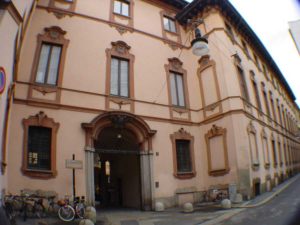 Close to the Scala there is the 18th century Palazzo Clerici , which contains one of the finest artworks in Milan: the famous fresco of Giambattista Tiepolo “The Sun’s chariot, guided by Mercury, illuminates the world”. As the building now houses the Institute for International Policy Studies (ISPI), the Galleria degli Arazzi (Tapestry Gallery) of which the fresco decorates the ceiling, can only be visited on appointment or on some special dates (see the ISPI website ). The tapestries in the Galleria are from Brussels and designed by Rubens , representing four events in the life of Moses. Another beautiful Tiepolo fresco may be admired at the Palazzo Dugnani.
Close to the Scala there is the 18th century Palazzo Clerici , which contains one of the finest artworks in Milan: the famous fresco of Giambattista Tiepolo “The Sun’s chariot, guided by Mercury, illuminates the world”. As the building now houses the Institute for International Policy Studies (ISPI), the Galleria degli Arazzi (Tapestry Gallery) of which the fresco decorates the ceiling, can only be visited on appointment or on some special dates (see the ISPI website ). The tapestries in the Galleria are from Brussels and designed by Rubens , representing four events in the life of Moses. Another beautiful Tiepolo fresco may be admired at the Palazzo Dugnani. - The Rotonda della Besana
The Rotonda della Besana surprisingly happens not to be a roundabout but a historical building, an 18th century hospital graveyard , now turned into a park and exhibition center. It’s a nice little green area in busy Milan. Have a detailed look from above at the satellite map to see the peculiar shape of this building. An interior 360 degree view is available here . A few years ago the artist Luciano Maciotta developed a light project for the building, pictures of which you can see at the Light Studio website (flash player required). - The Sant’Alessandro church
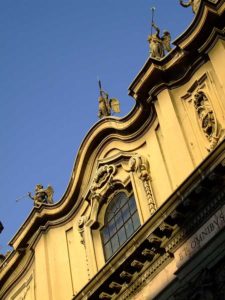 Like the Sant’Antonio Abate , the Sant’Alessandro is situated not far from the Duomo , to the south-west in this case. And also like in the Sant’Antonio , you’ll find a treasury of 17/18th century Lombard baroque art here. An overview of some major works : an Assumption; a Nativity and a Crucifixion by Procaccini; a Flagellation by Crespi; the confessionals, of engraved wood/marble inlaid with precious stones; the pulpit, decorated with gemstones; the vaulted dome frescoed by Abbiati; the main altar with gems bound with gold-plated bronze . The hypothesis is that the praetorium was called “ di Zebedia ” after a commanding judge of the time. The old square where the church stands is one of the very few spaces in Milan that have remained untainted by post-war reconstruction. At the opposite end of the square is the Palazzo Trivulzio , worth a quick look. Not accessible for the disabled.
Like the Sant’Antonio Abate , the Sant’Alessandro is situated not far from the Duomo , to the south-west in this case. And also like in the Sant’Antonio , you’ll find a treasury of 17/18th century Lombard baroque art here. An overview of some major works : an Assumption; a Nativity and a Crucifixion by Procaccini; a Flagellation by Crespi; the confessionals, of engraved wood/marble inlaid with precious stones; the pulpit, decorated with gemstones; the vaulted dome frescoed by Abbiati; the main altar with gems bound with gold-plated bronze . The hypothesis is that the praetorium was called “ di Zebedia ” after a commanding judge of the time. The old square where the church stands is one of the very few spaces in Milan that have remained untainted by post-war reconstruction. At the opposite end of the square is the Palazzo Trivulzio , worth a quick look. Not accessible for the disabled. - The Certosa di Garegnano monastery
A bit further out of city center, in a straight line north-west from the Arco della Pace , lies this monastery of the Carthusian order. The monastery was originally founded in the 14th century by the Visconti , but the church is about all that remains today. It has some later additions, like the 18th century facade shows. The main reason to visit the church are the Renaissance frescoes and paintings of Crespi (depicting the story of San Bruno , founder of the Carthusian order), of Caravaggio ‘s teacher Peterzano (Nativity, The Adoration of the Magi, Resurrection, Madonna with the Child and Saints and the Ascension) and of Zenale ( San Michele ). - Monza
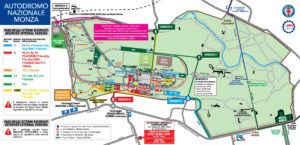 Monza is mainly known abroad for its Formula 1 racing track, but hosts a few other artistic and historical gems as well, apart from being a pleasant city to visit on its own. There is the historical city and there is the park of which the Autodrome is part. The major attraction in the church is the Teodolina treasury , which counts as one of the most important treasuries in artistic-historical value in the world. See the separate blog post about Monza for more info.
Monza is mainly known abroad for its Formula 1 racing track, but hosts a few other artistic and historical gems as well, apart from being a pleasant city to visit on its own. There is the historical city and there is the park of which the Autodrome is part. The major attraction in the church is the Teodolina treasury , which counts as one of the most important treasuries in artistic-historical value in the world. See the separate blog post about Monza for more info.
